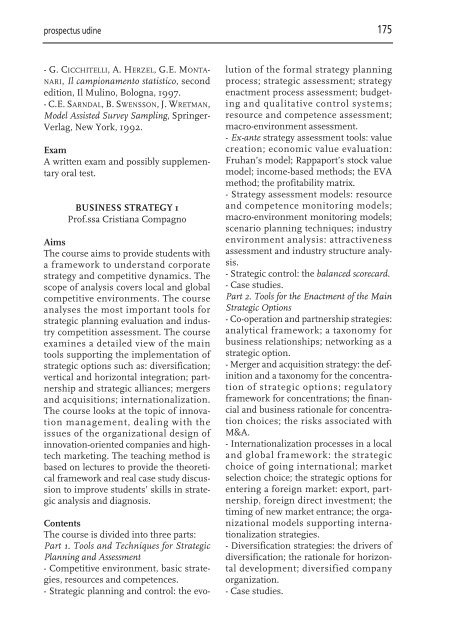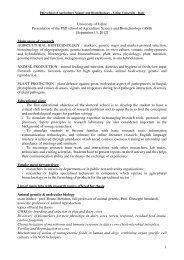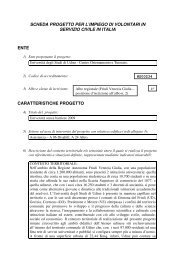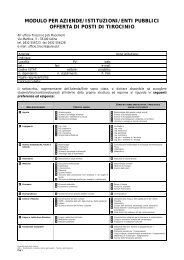â¢GUIDA ECONOMIA 07-08 - Università degli studi di Udine
â¢GUIDA ECONOMIA 07-08 - Università degli studi di Udine
â¢GUIDA ECONOMIA 07-08 - Università degli studi di Udine
Create successful ePaper yourself
Turn your PDF publications into a flip-book with our unique Google optimized e-Paper software.
prospectus u<strong>di</strong>ne<br />
175<br />
- G. CICCHITELLI, A. HERZEL, G.E. MONTA-<br />
NARI, Il campionamento statistico, second<br />
e<strong>di</strong>tion, Il Mulino, Bologna, 1997.<br />
- C.E. SARNDAL, B. SWENSSON, J. WRETMAN,<br />
Model Assisted Survey Sampling, Springer-<br />
Verlag, New York, 1992.<br />
Exam<br />
A written exam and possibly supplementary<br />
oral test.<br />
BUSINESS STRATEGY 1<br />
Prof.ssa Cristiana Compagno<br />
Aims<br />
The course aims to provide students with<br />
a framework to understand corporate<br />
strategy and competitive dynamics. The<br />
scope of analysis covers local and global<br />
competitive environments. The course<br />
analyses the most important tools for<br />
strategic planning evaluation and industry<br />
competition assessment. The course<br />
examines a detailed view of the main<br />
tools supporting the implementation of<br />
strategic options such as: <strong>di</strong>versification;<br />
vertical and horizontal integration; partnership<br />
and strategic alliances; mergers<br />
and acquisitions; internationalization.<br />
The course looks at the topic of innovation<br />
management, dealing with the<br />
issues of the organizational design of<br />
innovation-oriented companies and hightech<br />
marketing. The teaching method is<br />
based on lectures to provide the theoretical<br />
framework and real case study <strong>di</strong>scussion<br />
to improve students’ skills in strategic<br />
analysis and <strong>di</strong>agnosis.<br />
Contents<br />
The course is <strong>di</strong>vided into three parts:<br />
Part 1. Tools and Techniques for Strategic<br />
Planning and Assessment<br />
- Competitive environment, basic strategies,<br />
resources and competences.<br />
- Strategic planning and control: the evolution<br />
of the formal strategy planning<br />
process; strategic assessment; strategy<br />
enactment process assessment; budgeting<br />
and qualitative control systems;<br />
resource and competence assessment;<br />
macro-environment assessment.<br />
- Ex-ante strategy assessment tools: value<br />
creation; economic value evaluation:<br />
Fruhan’s model; Rappaport’s stock value<br />
model; income-based methods; the EVA<br />
method; the profitability matrix.<br />
- Strategy assessment models: resource<br />
and competence monitoring models;<br />
macro-environment monitoring models;<br />
scenario planning techniques; industry<br />
environment analysis: attractiveness<br />
assessment and industry structure analysis.<br />
- Strategic control: the balanced scorecard.<br />
- Case <strong>stu<strong>di</strong></strong>es.<br />
Part 2. Tools for the Enactment of the Main<br />
Strategic Options<br />
- Co-operation and partnership strategies:<br />
analytical framework; a taxonomy for<br />
business relationships; networking as a<br />
strategic option.<br />
- Merger and acquisition strategy: the definition<br />
and a taxonomy for the concentration<br />
of strategic options; regulatory<br />
framework for concentrations; the financial<br />
and business rationale for concentration<br />
choices; the risks associated with<br />
M&A.<br />
- Internationalization processes in a local<br />
and global framework: the strategic<br />
choice of going international; market<br />
selection choice; the strategic options for<br />
entering a foreign market: export, partnership,<br />
foreign <strong>di</strong>rect investment; the<br />
timing of new market entrance; the organizational<br />
models supporting internationalization<br />
strategies.<br />
- Diversification strategies: the drivers of<br />
<strong>di</strong>versification; the rationale for horizontal<br />
development; <strong>di</strong>versified company<br />
organization.<br />
- Case <strong>stu<strong>di</strong></strong>es.
















